The number of dementia cases in the world has exceeded 50 million; and more than US$1 trillion is spent annually on their care. There will be 150 million dementia cases worldwide in 2050. Exponential growth of the funds needed for dementia care will thus be a major global challenge. Although dementia is most commonly known as a memory impairment, there are other burdens of care brought about by the disease, behavioral and psychiatric symptoms such as depression, delusions, hallucinations, restlessness, wandering, and apathy; these not only increase the stress of the caregiver but also raise patient mortality rates.
“Non-medication treatment” is the core for treating the behavioral and psychiatric symptoms of dementia. However, it is highly dependent on labor and regular professional assessment. An accurate assessment can achieve early detection of changes in the mental and behavioral conditions that are associated with dementia; allowing the modification of the treatment plan immediately, which is key to improving the quality of dementia care. However, the Neuropsychiatric Inventory (NPI) conducted by professionals is difficult to implement on a regular basis in long-term healthcare business, which has an impact on the modifying of healthcare plans and leads to a reduction in healthcare quality.
The present invention includes two key technologies: first, thelightweight and highly accurate deep-learning technology to recognize emotional information; second, run a predictive algorithm with the ability to determine the traits of emotional shift and predict NPI scores and identify individual symptoms. Product development can be combined with the existing facial recognition access control system and temperature sensing system, and can be used simultaneously in healthcare centers or any other activity sites that primarily consist of elderly people to improve the quality not only in pandemic prevention, but also in access control, and quality of healthcare. The second-stage design principle greatly reduces the number of data samples required for updating the algorithm, enhances development costs for subsequent promotion, application, and sales, and accelerates global promotion.
The invention has been published in top journals, patented and commercialized, and has been promoted in a commercial sales planwhich has profound development potential.
https://innoaward.taiwan-healthcare.org/award_detail.php?REFDOCTYPID=0mge2qqssdm4fd72&num=1&REFDOCID=0r5bw7oa0ei3uf7f


